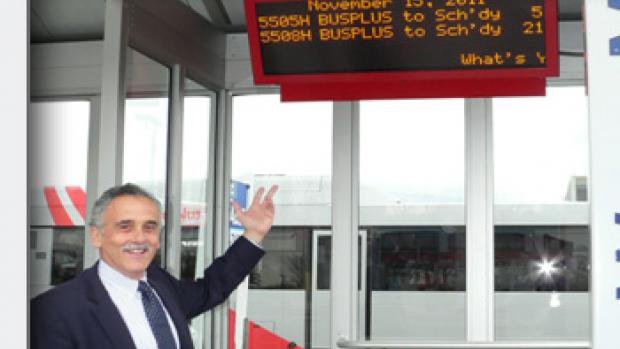
November 15, 2011
To learn how the queue jumper and traffic signal priority system work, click on the BusPlus simulation video.
To learn additional facts about traffic signal priority, click here for a fact sheet.
Customers who wish to learn more about bus arrival predictions or create an account to set up alerts can visit www.cdta.org or bustime.cdta.org.
CDTA INTRODUCES HIGH TECH AMENITIES FOR PREMIUM BUSPLUS SERVICE
(Albany, NY) –The Capital District Transportation Authority (CDTA) today announced the introduction of new amenities on BusPlus service to help expedite travel time, improve customer communications and ease congestion on Route 5. The introduction of Real Time Passenger Information (RTPI), coupled with queue jumper and traffic signal priority systems, and complimentary wireless internet service (WiFi) offer a host of conveniences to customers.
“CDTA is embracing modern technology to improve service reliability and communications, increase satisfaction for existing riders, and attract new riders,” said CDTA Chairwoman Denise Figueroa. “Adding these amenities is what makes BusPlus the premium way to travel.” According to CDTA surveys, receiving real time information was the number one amenity requested by customers, and over 50% of BusPlus customers have mobile devices, making this technology a natural fit.
“I want to commend CDTA for their work to use cutting edge technology for the benefit of its customers,” said Congressman Paul Tonko. “Employing these innovative technologies represents a continued investment in public transportation that makes the service more reliable and attractive to riders, and reduces congestion and pollution by taking cars off our roadways.”
BusPlus customers now have the ability to receive up-to-the-minute arrival information, and to access free Internet services while riding. Real time passenger information (RTPS) takes the guesswork out of waiting for the next bus ride by using Global Positioning System (GPS) satellites to determine bus location and speed.
Key features of BusTime Passenger Information System include:
- Arrival predictions for the next 2-3 buses
- Live bus tracking to show vehicle location and route progress using Google Maps
- Dynamic LED message signs
- Accessibility through any device with Internet access, such as smart phones, traditional cell phones, personal computers, and electronic signs at CDTA stops
-
Email and text message service alerts
Electronic signs are installed in 8 different locations: East bound and West bound stations at West Mall, Manning, Village Center, and Division with more to be installed at the remaining 15 BusPlus stations along Route 5 next year.
Customers can access BusPlus RTPI through the digital signage located at select stations, traditional computers, web-enabled smart phones, text messaging, and e-mail. Live predictions and the ability to sign up for alerts are available at bustime.cdta.org. To use on-demand text messaging, customers need to identify the 5 digit number on the nearest bus stop sign, and text cdtabus [stop id #] to 41411. When accessing free WiFi on the BusPlus line, customers only need to open their web browser and accept the terms and conditions.
Queue jumper and traffic signal priority systems, considered key characteristics of bus rapid transit services, give buses priority at intersections, helping to improve traffic flow and enhance safety. Queue jumpers are short sections of “bus only” lanes that allow transit vehicles to “jump the queue” of waiting cars at congested intersections. The queue jumpers are installed and fully operational along Route 5 at three locations: Wolf Road Westbound, New Karner Road (West Bound) and Nott Terrace (Eastbound.) CDTA’s first queue jumpers were introduced to the Capital Region in June 2003, and installed at the CDTA Fulton and 3rd and Fulton and 4th bus stops in Troy, New York.
Traffic Signal Priority employs technology that gives buses an extra 6 second lead-time ahead of other vehicles when running behind schedule. Traffic Signal Priority systems are installed at 44 intersections along the 17-mile corridor between downtown Albany and downtown Schenectady.
Benefits of Queue Jumper and Traffic Signal Priority systems include:
- Fewer stops and reduced travel times and more consistent service
- Improved schedule reliability
- Lower fuel consumption and emissions
- Increased air quality and environmental sustainability
Studies show that Bus Rapid Transit service leads to increased ridership and economic development and BusPlus has earned double digit increases in ridership since being unveiled in April 2011.
“We are very pleased to see the double-digit increase in ridership on the Route 5 BusPlus service. Introducing new technologies to provide “real-time” travel information to customers will make public transportation more convenient, and will enable riders to better plan their commute,” stated Niskayuna Town Supervisor Joe Landry.
“Route 5 is the Capital Region’s busiest travel corridor, and BusPlus is helping insure it remains a vital connector,” said Town Supervisor Paula Mahan. “With its streamlined service and environmentally friendly buses, BusPlus means that traffic moves more smoothly through the corridor. It also expands affordable and convenient travel options for area residents. BusPlus is really a big plus for everyone, and I thank CDTA for its leadership in developing it.”
With $5.5 million in federal funds awarded to CDTA last month, an additional 22 real time arrival signs, new shelters, security cameras and 911 blue light phones will be added along the route in 2012. Future plans may include extending real time information applications to other high volume routes following a successful launch on Route 5.
The RTPI system was implemented in partnership with Clever Devices of Plainview, New York. Clever Devices’ transit technology solutions provide Intelligent Transportation Systems for all modes of public transportation including fixed and flex route, Bus Rapid Transit (BRT), light rail, paratransit, and commuter rail systems. Additional equipment and technology was provided by Hewlett-Packard, In Motion Technology, and Sprint.
The Queue Jump Lanes and Stations were constructed by Callanan Industries, Inc., while Traffic Signal Priority equipment was installed by Innovations in Transportation Inc. (INIT) of Chesapeake, Virginia.
CDTA Transit Signal Priority Sheet
What is TSP?
Traffic Signal Priority (TSP) also known as Transit Signal Priority, offers buses priority in real time by extending the green and limiting the red traffic signal phases at certain intersections along the NY Route 5 corridor. Priority is based on specific conditions, such as passenger load and schedule adherence.
Where is TSP?
There are 66 signalized intersections along the NY Route 5 corridor. TSP is equipped at 45 of these intersections covering both the east and west bound directions. Additional corridors, such as Wolf Road, Western and Washington Avenues, will be considered for TSP at a later date.
What routes will be offered TSP?
Although all of CDTA’s fleet is equipped with TSP equipment, Route #905 vehicles will be the only buses programmed to activate TSP. Routes #1 and #355 will be considered at a later date.
How does it work?
The system will operate transparently and will be invisible to the driver. The buses will use GPS and odometer distance calculations to automatically request TSP as it travels along the Route 5 corridor. Other variables used for granting green extension include pedestrian activity, cycle lengths and the number of traffic signal phases just to name a few. As a result, the driver and passenger will be unable to detect TSP in action due to the complex set of variables used to calculate the exact priority for each bus. CDTA staff will gauge the effectiveness of TSP toward reducing travel times and improving on-time performance along the corridor by utilizing various reporting options.
Where does the bus request TSP?
On average, buses request TSP upon reaching 800 feet of the approaching intersection. At certain locations, the distance can be as large as 2000 feet and as small as 50 feet.
How do we know it is working?
Various reporting options will be available to CDTA for tracking the functionality and effectiveness of TSP. These reports will stem from our existing mobile data communications system, INIT-Innovations in Transportation, and from the central systems of the various municipalities where TSP is in operation. This includes the NYS DOT, the City of Albany and the City of Schenectady.
What impact, if any, will a signal outage have on the system?
If the traffic light is dark or in “flasher mode”, then there will be no TSP priority received.
Will there be additional TSP installations along the route 5 corridor?
Traffic signal installations under consideration include the site of the Albany OTB and in front of the new Mansion Square Mall in Niskayuna. At both locations, TSP will be included as part of the final specifications for installation.
Customers who wish to learn more about bus arrival predictions or create an account to set up alerts can visit www.cdta.org or bustime.cdta.org. To learn how the queue jumper and traffic signal priority system work, click on the BusPlus simulation video.
